[Interviewed by S. L. Sanger, from Working on the Bomb: An Oral History of WWII Hanford, Portland State University, 1995]
I’m from Arkansas. Little Rock. I went to work for Du Pont, war plants in Tennessee, then Alabama, then Tennessee again, Oak Ridge. Du Pont built a mockup of Hanford at Oak Ridge. Well, I worked on that as a carpenter. At the end of the job at Oak Ridge, they classified me as a millwright. A millwright is kind of a mechanical carpenter. At one time millwrights and carpenters was in the same local, but millwrights went more for setting machinery.
We kind of nicknamed the Oak Ridge plant the chewing gum plant or something of that nature, Hanford too, we didn’t what we were working on. I came out here to Hanford in July, ‘43.
I worked a week or such a matter at the construction camp, then I got sent out to 2-West. They sent me up to be an expediter, furnish materials for the crafts. You know, run materials down for the crafts. A person would have to be there to really understand the madhouse that was going on. They was hiring everybody that was loose, and they got here and there was nothing you might say for them to do or nowhere to put `em. Some of the people wouldn’t stay three days before they would be gone again.
I worked primarily a lot with millwrights and machinists. A lot of our stuff come through the machine shop. For instance, somebody would give an order for so many hundred tie rods, a certain length, or something like that. That was my job. I would collect my information of what the craft foremen or general foreman would want, and then I would supply that to him, from the millwrights, or the machine shop or the lumber yard. I had around 140 foremen at one time ordering through me. That went on for quite a long while, I don‘t know, six or eight months. Eight months is a long time in a construction crew.
After I worked at the reactor areas for a few months then the job was winding down and we were given a chance to go on maintenance or into operations. I went into operations, at the 300 Area, processing uranium to get ready for the reactors. That was in the latter part of ’44. My job was primarily to run a turret lathe. We were cutting the slugs. The uranium looked like, as best as I can explain it, a piece of cold-rolled iron. It came in billets, then it was hot and extruded out into smaller rods and then the smaller rods is what we turned. It was precise work, I think we had about five or sixth-thousandths of an inch tolerance. A slug was about eight inches long and an inch and five-eighths in diameter, but in fact I’m not gonna tell you those things. They were canned in aluminum, but the exact measurements I’m not gonna tell you.
I had no big complaint living in the barracks. They were two men to a room. Of course it was like batching anyplace, or living anyplace, you really had no privacy. I just wanted a place to sleep. They furnished good bedding. The messhall was very good, I would say it was exceptionally good food there. The variety was good, and plentiful. It was sanitary, I got no complaints about it.
The bombs wasn‘t a big surprise. Oh, cause really I was one of those type of people that as far as the secrecy and all was concerned I didn’t let it bug me, I didn’t care in the least, the less I thought about it the better off I figured I was and so consequently if they said we was making chewing gum it was all right with me. But they dropped the bomb, it all fell in place.




